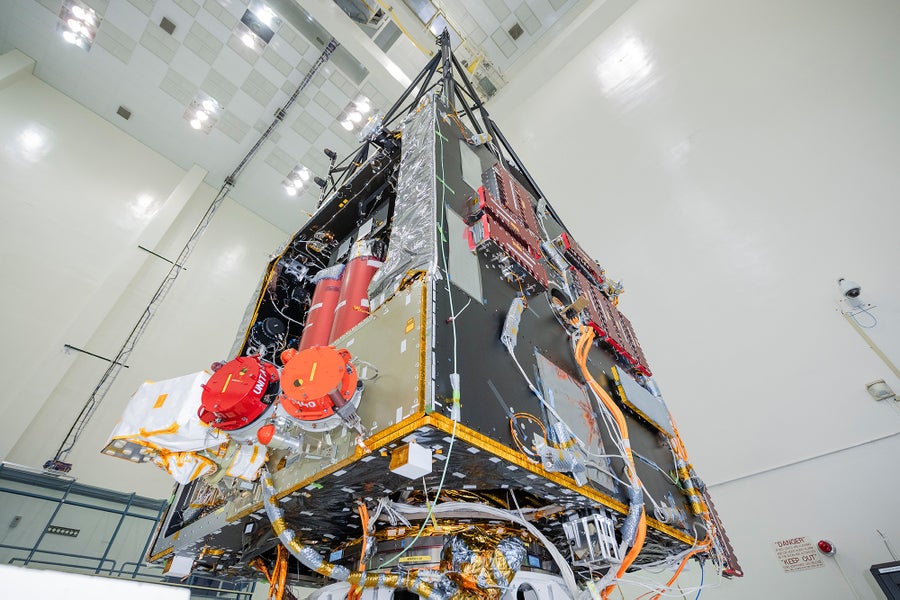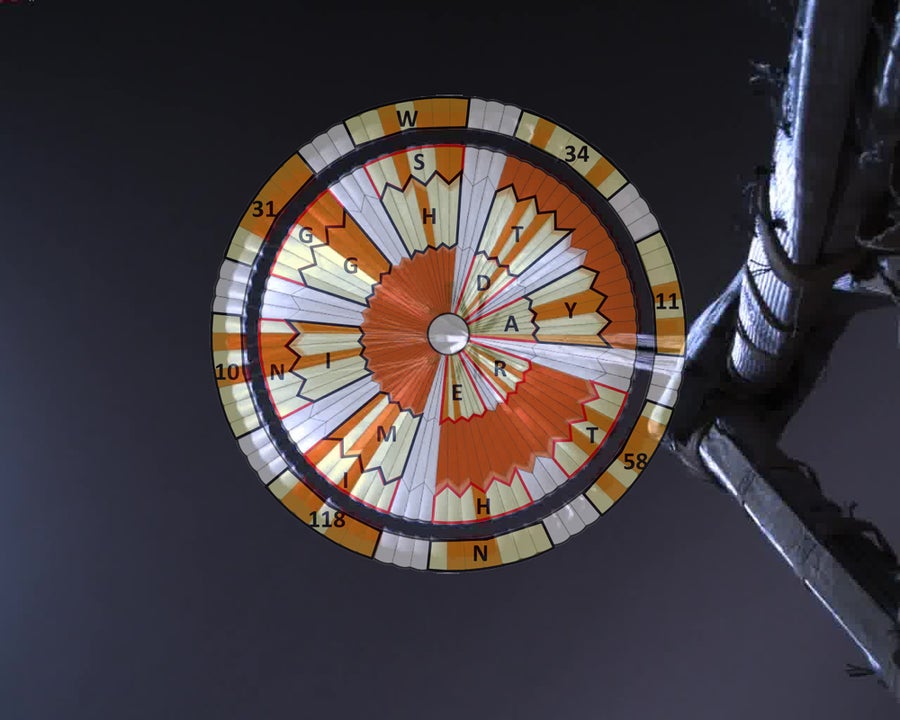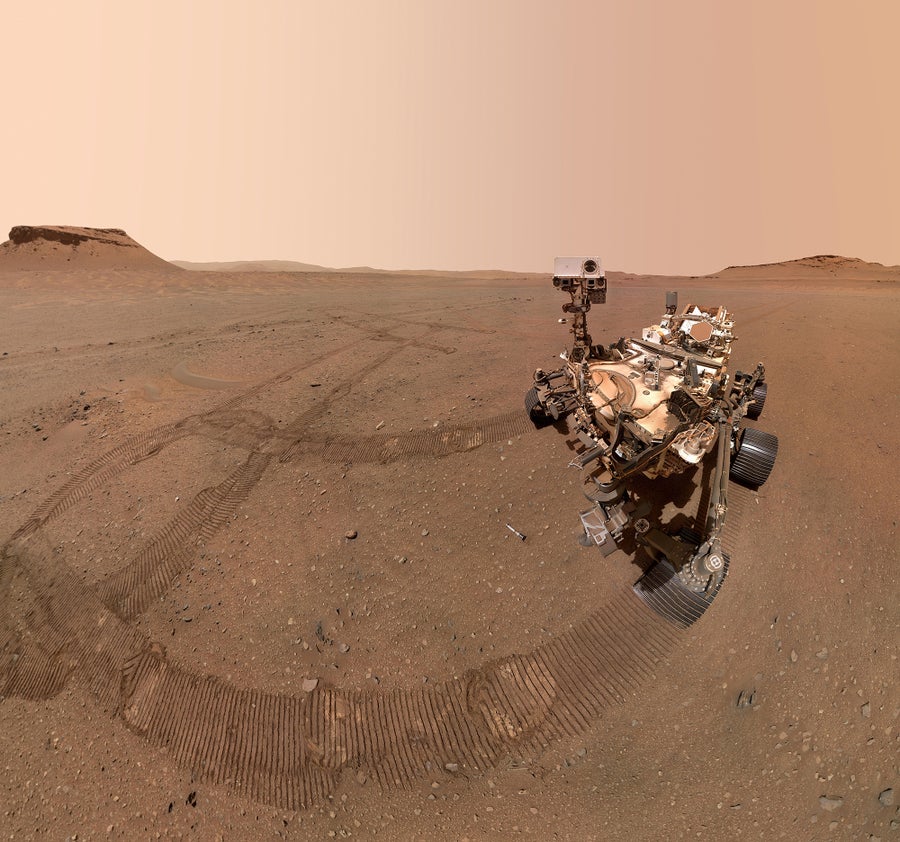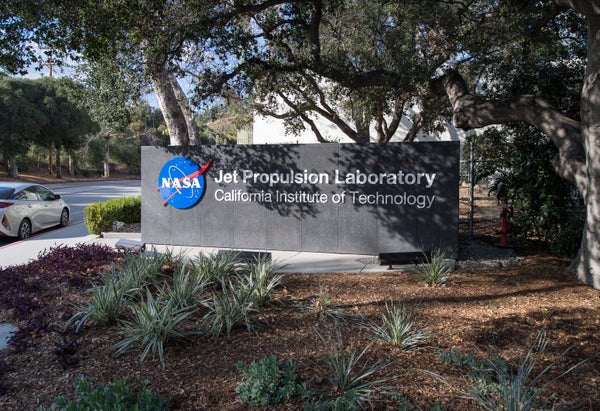Scientists at NASA’s Jet Propulsion Laboratory (JPL) can now breathe a collective sigh of relief. After a year-long delay, the lab’s Psyche mission finally launched in October to visit a metal-rich asteroid with the same name. The mission is a huge win for scientists who hope to better understand the role that these bizarre objects played in assembling the early solar system. And its liftoff is also a redemption for JPL itself, which faced a number of challenges as it prepared Psyche for launch—chief among them the waves of skilled-worker resignations that left the lab understaffed.
That is no small snag. It is also rather surprising. Sure, NASA as a whole already wears the crown of being the highest-ranked federal agency to work for, but JPL is widely seen as one of its most brilliant jewels. Where else can one’s work involve flying an aircraft across Mars or building a spacecraft to explore a watery moon of Jupiter for conditions suitable for extraterrestrial life? To many, it is a dream job. So why have some of JPL’s most vital workers jumped ship? To find out, Scientific American interviewed more than a dozen current and past employees who blame much of the brain drain on the high-stakes, high-stress atmosphere of the lab. Missions, not people, are the lab’s top priority, they say.
Although JPL declined to comment on a number of these issues, the lab is pursuing fixes: beefing up efforts to attract and keep top talent, making management changes and ensuring that any revisions made clear from the Psyche delay percolate throughout the entire lab.
On supporting science journalism
If you're enjoying this article, consider supporting our award-winning journalism by subscribing. By purchasing a subscription you are helping to ensure the future of impactful stories about the discoveries and ideas shaping our world today.
Overstuffed and Understaffed
After Psyche’s slip last year, the space agency formed an independent review board to examine the misstep. The resulting report was “damning,” says Gentry Lee, JPL’s chief engineer for planetary science and a member of the Psyche review board.
The review argued that the lab had more missions than it had the capability to execute. Not only was JPL grappling with an overstuffed portfolio—which currently includes 43 missions plus another 15 that will soon launch—but it also had an understaffed program. The lab had been struggling to hire and retain some of its best workers, particularly midlevel employees, many of whom departed JPL to join commercial space companies. To make up for staffing shortages, JPL had placed employees in jobs that were beyond their experience level and left some positions unfilled entirely. That made it difficult for scientists and engineers to effectively voice their concerns to upper management—resulting in both the Psyche mission’s delay and the immense frustration of workers. During interviews, some employees even broke down in tears, says Thomas Young, a retired aerospace executive, who chaired the review. “It was a pretty depressed, disillusioned group of people,” he says.

A view of NASA’s Psyche spacecraft from July 2021 during its assembly and testing in a clean room at the Jet Propulsion Laboratory (JPL) in Pasadena, Calif. The mission launched in October 2023 after a one-year delay related to workforce issues at JPL. Credit: NASA/JPL-Caltech
JPL’s leadership took the review to heart and implemented several changes, including a redoubling of its hiring and retention efforts. “They left no stones unturned,” says Orlando Figueroa, a former NASA senior executive, who has chaired several recent reviews and was a member of the Psyche review board. The lab’s leaders increased the number of staff in their recruitment team. They put steps in place to retain crucial employees who were planning to leave. And they asked past employees to return. Laurie Leshin, JPL’s director since May 2022, notes that since she came onboard the lab has hired back more than 70 experienced employees who had left. “People remember what is so special about working at a place like JPL, where one day you’re addressing Earth’s water challenges, and the next day you’re flying helicopters on Mars,” Leshin says. “It’s a pretty amazing place to be, and people want to be a part of it.”
Some of this allure could arguably arise from the sky-high public perceptions of NASA as a whole—the space agency is frequently ranked as the best place to work in the federal government. But that halo effect can’t entirely account for JPL’s sterling reputation, which demonstrably exceeds that of all other research centers run by or affiliated with NASA. Last year, for example, the lab ranked number 12 on Glassdoor’s Top 100 Employees’ Choice Awards list. (JPL’s east-coast competitor, the Applied Physics Laboratory at Johns Hopkins University, ranked number 15, and no other NASA center even made the list.)
Indeed, much of NASA’s modern-day cachet traces back to JPL-sourced successes; the halo effect goes both ways. The lab’s spacecraft have visited every planet in the solar system, the sun and even interstellar space. Until the successful touchdown on Mars of China’s Zhurong rover in 2021, JPL had been responsible for each and every rover to reach the Red Planet. And the lab even played a role in the iconic Hubble Space Telescope’s vaunted redemption arc by helping bring the observatory’s flawed mirrors back into focus. “I remember when we landed the first spacecraft on Mars, and there were no dry eyes in the entire control room,” says Lee, who has worked at the lab for 40 years. “That kind of investment in your work is something that an awful lot of people want and is the thing that JPL offers that nobody else can.”
It is no wonder that top talent has long been drawn to the lab whose slogan, after all, has long been “dare mighty things.”
Dare Mighty Things, Indeed
Yet current and former employees interviewed by Scientific American argue that JPL’s slogan is precisely the problem: it takes precedence over all else—throwing any resemblance of a work-life balance out the door. Expectations of 50- to 60-hour work weeks are the norm for many employees, they say, and shifts spanning 24 hours or more are not unheard of. One past employee told Scientific American that he once worked a 36-hour day because urgent issues kept piling up. Another would work 10-hour days and still wake up in the middle of the night to monitor the spacecraft—over and over again. “It’s that, or this mission might end,” he says. “So people will do it.”
To some extent the wounds from overwork are often self-inflicted. A glorification of the grind is widespread throughout U.S. culture and is especially entrenched in the sciences. In 2020 Wellcome, a major research funder in London, surveyed more than 4,200 scientists and found that many researchers complained of long hours. In all, 40 percent reported working an average of 41 to 50 hours per week, and 32 percent reported working more than 50 hours per week. Even students reported similar hours. “If you go all the way back to being trained as a scientist or engineer, you ‘pay your dues’—they literally say that,” says one current longtime JPL employee whom we will refer to as Charlotte. “It’s almost like if you’re in this field, you’re used to being abused.”
But many sources agreed that JPL is an extreme example because of its weighty legacy of pulling off high-stakes, high-profile missions that no one else even attempts. “JPL takes advantage of the sense of responsibility people have as a team member to get something done,” Charlotte says. Team members “are so earnest about wanting to do their part to help mission success that they make it work—regardless of health, regardless of the hours. It’s almost a joke how much JPL expects people to execute.”
Zahra Khan, who worked at JPL for nearly three years, says one particularly potent example is the lab’s clean rooms, where hazmat-clad technicians build rovers and other space-rated instruments. Those rooms are often oversubscribed, forcing workers to wait for their turn—and sometimes to toil through the night alone. To boot, many clean-room tests cannot be paused, and no food or drinks are allowed inside, making meaningful work breaks impossible. “You can’t keep hydrated if you work in there,” Khan says. “People need to drink water. People need to go to the bathroom.... But we’re not thinking about people’s needs—we’re just thinking about the mission’s needs.”
That was especially true before the launch of the Perseverance Mars rover at the beginning of the COVID pandemic, argues one past employee whom we will call Liam. While team members struggled with isolation, personal health concerns, and more, they worked overtime remotely to launch the rover on schedule. Liam recalls laboring around the clock, often jumping from shifts in the middle of the night to the day and back again. “At the end of the day, the project was completely understaffed—completely understaffed,” Liam says. “Many of us had to step up in crazy ways.”

JPL’s motto, “Dare Mighty Things,” appears in binary code in the colorful parachute canopy of NASA’s Perseverance Mars rover during its descent to the Red Planet, as seen in this annotated image. The rover’s touchdown in February 2021 was a triumph for JPL—and the start of a stressful, demanding phase for workers supporting the mission’s surface operations. Credit: NASA/JPL-Caltech
The situation only got worse when Perseverance reached the Red Planet, Liam says. To support the rover, he and his teammates had to switch to “Mars time,” where they adapted to the Martian day, which is nearly 40 minutes longer than Earth’s. This means employees on Mars time slide out of sync with our own world’s turning—and suffer something akin to constant jet lag as they essentially move through a new time zone every day. “It was clear that upper management expected us to push through regardless of any challenges happening outside the lab because the robot was the first priority,” Liam says. “It resulted in incredible burnout across all the teams. Many of us are honestly still recovering from it.”
JPL declined to comment on these issues.
A Homegrown Problem
Meanwhile commercial space companies are eager to lure JPL’s employees away with promises of higher salaries, promotions and better hours. But whether similar problems also pervade private industry—especially because such issues appear to be systemic throughout U.S. culture and the sciences more generally—is hard to say.
Indeed, Lee argues that the grass is always greener on the other side. “In truth, the work that we do here often requires personal sacrifice,” he says. “And many people think that they can achieve a better work-life balance somewhere else. Now I tell them, ‘You’re kidding yourself.’” At JPL, Lee worked on NASA’s Viking missions for eight years. “There was never a week in which I didn’t work at least 45 to 50 hours,” he says. “And there was never one thought that I had no work-life balance. I was going to be a part of the first mission that would ever land on another planet! And yes, it’s true [that] at the time, I was not married; I did not have children. But I was perfectly willing to make that sacrifice.”
“You make all kinds of trades in life,” Lee continues. “If you’re going to spend 40-plus hours every week doing a job, to have a job that you don’t like and are not thrilled by and are not passionate about is wasting your life. It doesn’t matter how much it pays. If it doesn’t give you any internal fulfillment, how can you possibly justify all that time expenditure?”
But for many, the pay does matter—especially because JPL is based in Pasadena, Calif., where the cost of housing is 200 percent higher than the national average. One current employee says that in 2021 he was spending 45 percent of his salary on housing, not including utilities. “If I had the expenses of a family on top of that, there simply wouldn’t be enough to go around,” he says. “It seems like the people making the decisions all bought their houses 20 years ago for 20 percent of their current value.” Still, he says that being able to work on some of NASA’s greatest missions is why he has decided to stay. “But JPL relying on [prestige] as a job ‘perk’ to keep underpaid people around is frankly embarrassing,” he argues.
It is also ironic, argues Casey Dreier, chief of space policy at the Planetary Society. “NASA’s stated goal for years was to create a vibrant commercial space community that now is actually acting as a competitor for its best talent,” he says. There is going to be some adjustment, Dreier says, as NASA learns how to better compete for in-demand aerospace workers.
‘A Sea Change’
Even the harshest critics interviewed by Scientific American hold out hope for change—much of it tied to JPL’s newest director, Leshin. “It was amazing to see the amount of trust that was accorded to her right from the get-go” after her arrival a year and a half ago, says one current employee whom we will call Ava. “She was very open. She was welcoming. She was engaged. She was personable. She led with her pronouns at her very first town hall before she even started [it].”
That was not all. During her first public address, Leshin promised to bring back the ombuds position—a neutral party who is not a mandated reporter and can help troubled employees learn about their options. She ensured that the lab started offering paid parental leave. She has, of course, tackled the Psyche issues head-on—applying those lessons on missions throughout the lab. And she has even added a word to the lab’s legendary slogan, which now reads “Dare Mighty Things Together,” noting that teamwork gets these missions off the ground.
“I think it points to Leshin actually seeing some of the writing on the wall, which is huge,” says one past employee. Leshin, for example, promoted Neela Rajendra to chief inclusion officer. Rajendra, in turn, built a new strategic action plan that prioritized JPL’s need for psychological safety, meaning that any team member should feel comfortable taking risks, expressing their concerns, asking questions and admitting their mistakes. Leshin made a full commitment to this plan this summer by including it within her own lab-wide strategic action plan.
“I’m seeing a lot of change,” Ava says. “And it’s being led both from the bottom and from the top. It really feels like a sea change.”
The Show Must Go On
A lot of that change has focused on the Psyche mission, which became clear within weeks of Leshin’s arrival. On top of the lab’s efforts to revamp its hiring and retention practices, JPL made management changes by adding roughly a dozen experienced engineers and scientists to the Psyche team. It was enough to get the mission off the ground. “They have obviously spent hour after hour after hour responding to our findings and recommendations,” Young says. “They have done what’s necessary to get the program corrected in a first-class fashion.”
Nevertheless, JPL has faced other obstacles. When Psyche was first delayed, NASA chose to remove a mission to Venus from the lab’s planetary plate—delaying it by at least three years. Then Mars Sample Return (MSR) hit a major financial snag. This mission, managed by JPL, is a multibillion-dollar collaboration between NASA and the European Space Agency that is slated to bring the first samples of Martian rocks back to Earth. But an independent assessment of the plan that was released in September reports that MSR is already wildly over budget and behind schedule. It has an estimated price tag of $8 billion to $11 billion, which is more than double that found by a 2020 review, and there is essentially no hope of launching as planned before the end of the decade.

The Perseverance rover captured this selfie on Mars shortly after placing several filled sample tubes on the planet’s surface. These tubes and others are meant for retrieval and return to Earth by future spacecraft as part of the JPL-managed Mars Sample Return program, an international collaboration between NASA and the European Space Agency. Credit: NASA/JPL-Caltech/MSSS
“I think there are going to be bigger hiccups as time moves forward,” says one past employee. And those issues might percolate beyond MSR. Another employee who worked on Europa Clipper—a different hard mission ahead that will orbit around Jupiter and repeatedly sweep past the ice-covered moon for which it is named—is not optimistic that Clipper will launch in 2024. Although staffing issues were temporarily alleviated when Perseverance launched, she argues that many of those engineers will now naturally gravitate toward the lab’s official top priority—returning samples from Mars—and siphon personnel from Clipper and other projects. This could in turn force JPL to hire new employees to fill those voids, perpetuating the trend of relying too much on engineers with too little experience to solve a plethora of hard problems—the exact stumbling block that led to Psyche’s setbacks.
But Leshin insists that the findings from the Psyche review have been applied to both MSR and Europa Clipper. And Figueroa, who chaired the MSR independent review and is currently chair of Clipper’s standing review board, has been keeping a watchful eye over both missions. He argues not only that Clipper is on track to launch next year but also that JPL as a whole is at capacity—meaning that it has the workforce it needs to deal with the work at hand. That is huge, given the number of empty positions during the Psyche troubles. It does not mean every problem has been solved, however.
“For me to tell you that the workforce has been taken care of—that there is nothing to worry about—well, I would be lying if I said that,” Figueroa says. JPL has adapted well, he says, by bringing in new hires at a rate that roughly equals that of outgoing employees (at least in number), yet turnover remains an issue. Training new hires to get up to speed on an organization as complex as JPL and missions as daring as MSR and Clipper adds time and cost, he says—two things that cannot be taken for granted when missions must launch on schedule and on budget. “We have reached a stable environment,” Figueroa says. “But we need to be vigilant because it could be perturbed quickly.”
Many argue that this is simply a new reality. “There is always going to be a demand between the commercial sector and NASA—they are drawing from the same source,” Figueroa says. And Lee agrees. “What we’re seeing is a problem that exists throughout the aerospace industry,” he says. “The number of people who can employ the kind of talent that we need to do this kind of work has increased drastically in the last half-decade to decade. And quite frankly, we can’t pay as much as these private companies can. And so we have to keep our people happy by giving them the joy of working on something that nobody else can do and try to do the best we can to keep them fired up.”
In other words: dare mighty things. But Scientific American’sreporting suggests that might not be enough—especially if employees continue to feel like they are “cogs in the machine” (as one past employee put it) working horrendous hours for compensation they deem insufficient. It might even backfire. One past employee argues that young engineers will accept a position at JPL to add an impressive entry to their résumé while knowing they will soon move on. “They just look at JPL as a stepping stone,” she says. “In the space industry, you want people that are going to be around 20, 30 years to hold that longevity and train the next generation, but younger engineers know their value now. It’s not worth toughing out.” As such, many sources do not think that retention will dramatically improve. “You’re seeing that bleeding of talent because we’re not dumb—we know our worth,” Liam says. “And sorry, JPL, but we don’t get paid enough to keep suffering.”
